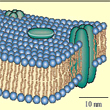Tuesday, 11 June 2013
Shedding Some Light on the First Cell Membranes
 Every living cell, including every neuron, has a cell membrane that separates the outside environment from the myriad biochemical reactions that take place inside the cell. Some of these enzymatic reactions are even involved in forming this membrane. It is this characteristic of living things—their ability to produce themselves—that Maturana and Varela have called autopoiesis.
Every living cell, including every neuron, has a cell membrane that separates the outside environment from the myriad biochemical reactions that take place inside the cell. Some of these enzymatic reactions are even involved in forming this membrane. It is this characteristic of living things—their ability to produce themselves—that Maturana and Varela have called autopoiesis.
But if it takes a membrane for there to be a living cell, and if it is the living cell that produces the membrane, then how do we solve this dilemma, which is similar in every way to the classic question, “Which came first, the chicken or the egg?” The only logical assumption is that at some moment at the start of evolution, a biochemical reaction capable of creating membranes was catalyzed by a non-organic molecule (a molecule that did not result from the metabolism of a living cell).
That is exactly the kind of reaction that chemists Neal Devaraj and Itay Budin have just managed to achieve. They used simple ingredients (water, oil, and detergent) and simple copper ions as a catalyst to join the two chains of lipids that form every cell membrane (which enables neurons to transmit nerve impulses). It is because certain lipids have heads that are attracted to water and tails that repel it that these lipids can form a double layer with the water-repellent tails facing one another and the hydrophilic heads facing the aqueous media outside and inside the cell.
By showing that membranes can be produced with these basic inorganic ingredients, Devaraj and Budin are suggesting that the very first cell membranes may have been formed in this way, without all the chains of complex biochemical reactions that now come into play in even the simplest cell. By folding over onto themselves to form a closed bubble, these primitive membranes may then have created the stable conditions required for the countless cascades of biochemical reactions characterizing living cells to gradually become established.
This theory sheds some very interesting light on the origins of life on Earth, as well as on the good old chicken-and-egg question. The next time someone brings it up, you can tell them all about these artificial membranes.
![]() Envelope for an Artificial Cell
Envelope for an Artificial Cell
![]() Qu’est-ce qu’un concept scientifique ? L’exemple de l’énaction (et de l’autopoïèse) de Francisco Varela.
Qu’est-ce qu’un concept scientifique ? L’exemple de l’énaction (et de l’autopoïèse) de Francisco Varela.
From the Simple to the Complex | Comments Closed







